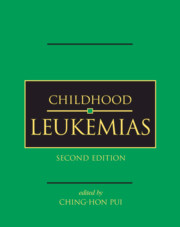Book contents
- Frontmatter
- Contents
- List of contributors
- Preface
- Part I History and general issues
- Part II Cell biology and pathobiology
- Part III Evaluation and treatment
- 14 Pharmacokinetic, pharmacodynamic, and pharmacogenetic considerations
- 15 Assays and molecular determinants of cellular drug resistance
- 16 Acute lymphoblastic leukemia
- 17 Relapsed acute lymphoblastic leukemia
- 18 B-cell acute lymphoblastic leukemia and Burkitt lymphoma
- 19 Acute myeloid leukemia
- 20 Relapsed acute myeloid leukemia
- 21 Myelodysplastic syndrome
- 22 Chronic myeloproliferative disorders
- 23 Hematopoietic stem cell transplantation
- 24 Acute leukemia in countries with limited resources
- 25 Antibody-targeted therapy
- 26 Adoptive cellular immunotherapy
- 27 Gene transfer: methods and applications
- 28 Minimal residual disease
- Part IV Complications and supportive care
- Index
- Plate Section between pages 400 and 401
- References
23 - Hematopoietic stem cell transplantation
from Part III - Evaluation and treatment
Published online by Cambridge University Press: 01 July 2010
- Frontmatter
- Contents
- List of contributors
- Preface
- Part I History and general issues
- Part II Cell biology and pathobiology
- Part III Evaluation and treatment
- 14 Pharmacokinetic, pharmacodynamic, and pharmacogenetic considerations
- 15 Assays and molecular determinants of cellular drug resistance
- 16 Acute lymphoblastic leukemia
- 17 Relapsed acute lymphoblastic leukemia
- 18 B-cell acute lymphoblastic leukemia and Burkitt lymphoma
- 19 Acute myeloid leukemia
- 20 Relapsed acute myeloid leukemia
- 21 Myelodysplastic syndrome
- 22 Chronic myeloproliferative disorders
- 23 Hematopoietic stem cell transplantation
- 24 Acute leukemia in countries with limited resources
- 25 Antibody-targeted therapy
- 26 Adoptive cellular immunotherapy
- 27 Gene transfer: methods and applications
- 28 Minimal residual disease
- Part IV Complications and supportive care
- Index
- Plate Section between pages 400 and 401
- References
Summary
Introduction
Hematopoietic stem cell transplantation (HSCT) in children was first performed in March 1969 in a child with leukemia, who received cells from a sibling donor. By 1975, HSCT was being used successfully to cure otherwise incurable leukemias in adults. The next two decades produced remarkable advances in our understanding of histocompatibility and brought the development of novel immunosuppressive drugs. With the establishment of international bone marrow donor registries, HSCT has become a thera-peutic option for an increasing number of patients with otherwise incurable leukemias. With the addition of unrelated cord blood transplantation and the possibility of including partially mismatched or three loci-mismatched haploidentical family members in the donor pool, a stem cell donor can now be identified for almost every patient with leukemia for whom allogeneic transplantation is considered to be superior to conventional chemotherapy. This chapter reviews practical aspects of HSCT, its application to children and young adults with leukemia, the acute and late toxicities associated with transplantation, and approaches to exploiting the antileukemic effect of allogeneic transplants while minimizing the short and long-term side effects in children with leukemia.
Donor selection for HSCT
The selection of donors for HSCT depends upon the match between the prospective donor and the recipient in terms of the products of a group of genes on chromosome 6, the so-called major histocompatibility complex (MHC). The products of the MHC tested for histocompatibility purposes are referred to as HLAs or human leukocyte antigens.
- Type
- Chapter
- Information
- Childhood Leukemias , pp. 599 - 624Publisher: Cambridge University PressPrint publication year: 2006
References
- 2
- Cited by



